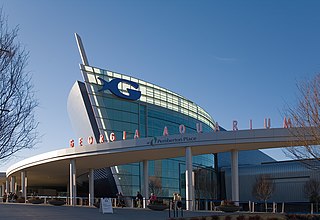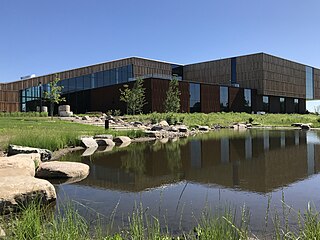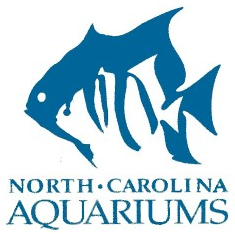
Ocean Isle Beach is a small seaside town in Brunswick County, North Carolina, United States. It was incorporated as a town in 1959 and is part of the Myrtle Beach metropolitan area. The population was 550 at the 2010 census.

The National Aquarium – also known as National Aquarium in Baltimore and formerly known as Baltimore Aquarium – is a non-profit public aquarium located at 501 East Pratt Street on Pier 3 in the Inner Harbor area of downtown Baltimore, Maryland in the United States. Constructed during a period of urban renewal in Baltimore, the aquarium opened on August 8, 1981. The aquarium has an annual attendance of 1.5 million visitors and is the largest tourism attraction in the State of Maryland. The aquarium holds more than 2,200,000 US gallons (8,300,000 L) of water, and has more than 17,000 specimens representing over 750 species. The National Aquarium's mission is to inspire conservation of the world's aquatic treasures. The aquarium's stated vision is to confront pressing issues facing global aquatic habitats through pioneering science, conservation, and educational programming.

Sea World is a marine mammal park, oceanarium, and a theme park located on the Gold Coast, Queensland, Australia. It offers attractions such as rides and animal exhibits and promotes conservation through education and the rescue and rehabilitation of sick, injured or orphaned wildlife. The park is commercially linked to Warner Bros. Movie World and Wet'n'Wild Gold Coast as part of the theme park division of Village Roadshow. The park has no affiliation with an American park chain of a similar name.

A shark attack is an attack on a human by a shark. Every year, around 80 unprovoked attacks are reported worldwide. Despite their rarity, many people fear shark attacks after occasional serial attacks, such as the Jersey Shore shark attacks of 1916, and horror fiction and films such as the Jaws series. Out of more than 489 shark species, only three of them are responsible for a double-digit number of fatal, unprovoked attacks on humans: the great white, tiger, and bull. The oceanic whitetip has probably killed many more castaways, but these are not recorded in the statistics.

Shedd Aquarium is an indoor public aquarium in Chicago, Illinois, in the United States. Opened on May 30, 1930, the 5 million US gal aquarium was for some time the largest indoor facility in the world. Today it holds about 32,000 animals.

Georgia Aquarium is a public aquarium in Atlanta, Georgia, United States. It exhibits hundreds of species and thousands of animals across its seven major galleries, all of which reside in more than 11 million US gallons (42,000 m3) of water. It was the largest aquarium in the world from its opening in 2005 until 2012 when it was surpassed by the S.E.A. Aquarium in Singapore and the Chimelong Ocean Kingdom in China; the Georgia Aquarium remains the largest aquarium in the United States and the third largest in the world.

The New England Aquarium is a nonprofit organization located in Boston, Massachusetts. The species exhibited include harbor and northern fur seals, California sea lions, African and southern rockhopper penguins, giant Pacific octopuses, weedy seadragons, and thousands of saltwater and freshwater fishes. In addition to the main aquarium building, attractions at Central Wharf include the Simons Theatre and the New England Aquarium Whale Watch. More than 1.3 million guests visited the aquarium each year prior to the outbreak of the COVID-19 pandemic.

The Aquarium of the Pacific is a public aquarium on a 5-acre (20,000 m2) site on Rainbow Harbor in Long Beach, California, United States. It is situated across the water from the Long Beach Convention Center, Shoreline Village, and the Queen Mary Hotel and Attraction.

The National Marine Aquarium, opened in May 1998, is situated in Britain's ocean city of Plymouth; it is the largest aquarium in the UK. It is home to over 4,000 animals and acts as an educational institution, teaching visitors about marine environments. The National Marine Aquarium has also engaged in ocean conservation work.

Sea Life Sunshine Coast at Mooloolaba, Sunshine Coast, Queensland, Australia is a marine mammal park, oceanarium and wildlife sanctuary. Sea Life Sunshine Coast is an institutional member of the Zoo and Aquarium Association (ZAA). The attraction is a Sea Life Centre owned by Merlin Entertainments, and is globally referred to as Sea Life Sunshine Coast by the firm. It was formerly known as UnderWater World.

The South Carolina Aquarium, located in Charleston, South Carolina, opened on May 19, 2000 on the historic Charleston Harbor in the former location of the Anson Borough Homes, a public housing project that was closed over soil contamination and flooding conerns. It is home to more than ten thousand plants and animals including North American river otters, loggerhead sea turtles, alligators, great blue herons, owls, lined seahorses, jellyfish, pufferfish, green moray eels, horseshoe crabs, sea stars, pythons, and sharks. The largest exhibit in the zoo is the Great Ocean Tank, which extends from the first to the third floor of the Aquarium and is the deepest tank in North America ; it holds more than 385,000 US gallons (1,460,000 L) of water and contains more than 700 animals. The Aquarium also features a Touch Tank, where patrons may touch horseshoe crabs, Atlantic stingrays, and other marine animals.

SEA LIFE Sydney Aquarium is a public aquarium that features a large variety of Australian aquatic life, displaying more than 700 species comprising more than 13,000 individual fish and other sea and water creatures from most of Australia's water habitats. Opened in 1988, it is regarded as one of Sydney's premier tourist attractions with over 55% of its visitors each year coming from overseas.

The Iziko South African Museum is a South African national museum located in Cape Town. The museum was founded in 1825, the first in the country. It has been on its present site in the Company's Garden since 1897. The museum houses important African zoology, palaeontology and archaeology collections.

The Bell Museum, formerly known as the James Ford Bell Museum of Natural History, is located at the University of Minnesota. The museum's new location on the St. Paul campus opened in 2018. The Minnesota wildlife dioramas showcase animal specimens from around the world. The museum also houses the 120-seat digital Whitney and Elizabeth MacMillan Planetarium. The museum is part of the university's College of Food, Agricultural and Natural Resource Sciences. The museum's former location in Minneapolis is closed in January 2017.

The Virginia Aquarium & Marine Science Center, formerly known as the Virginia Marine Science Museum, is an aquarium and marine science museum located in Virginia Beach, Virginia, just south of Rudee Inlet. The exhibits at the museum are contained in over 800,000 US gallons (3,028,000 L) of fresh and saltwater displays.

The Cox Science Center and Aquarium is located in West Palm Beach, Florida. Founded in 1959, the goal of the organization is to open every mind to science through the strategic programming of interactive exhibits and engaging community-based camps and events. The Cox Center has expanded since its creation and now houses over 50 hands-on exhibits, a planetarium, a 3000 square foot aquarium, a miniature golf course, and a large exhibit space that displays a temporary travelling exhibit. The Cox Center is a member of the Association of Science-Technology Centers program, which offers a membership that is redeemable at other ASTC science and technology centers around the world. The Cox Center occupies Dreher Park alongside the Palm Beach Zoo and offers deals for entrance to both facilities.

The National Museum of Marine Biology and Aquarium is the most notable museum and research institution for marine biology in Taiwan, which located in Checheng Township, Pingtung County, Taiwan.

North Carolina Aquariums is a system of three public aquariums located in Kure Beach, Roanoke Island and Pine Knoll Shores. All are operated by the Aquariums Division of the North Carolina Department of Natural and Cultural Resources since 1976 and were accredited by the Association of Zoos and Aquariums. All three aquariums feature dive shows, live animal encounters, and feeding programs.
Ingram Planetarium is a planetarium located at Sunset Beach in Brunswick County, North Carolina. The Board of Trustees of the Ocean Isle Museum Foundation, Inc. is the governing body of Ingram Planetarium as well as the Museum of Coastal Carolina, located at Ocean Isle Beach, North Carolina.

The Living Coast Discovery Center is an environmental education center with marine animal, animal and bird exhibits located in the Sweetwater Marsh Unit of the San Diego National Wildlife Refuge in Chula Vista, California. Permanent displays at the Living Coast focus on native animals and plants found in Southern California and San Diego Bay.



















